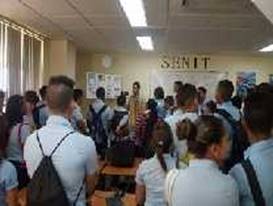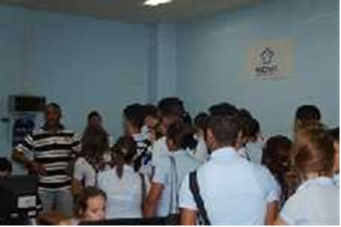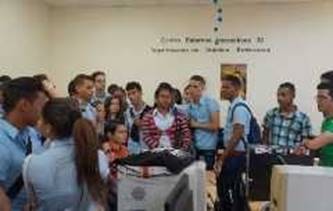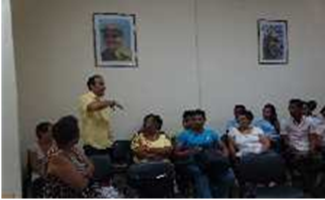Introduction
Career guidance is a basic element for the development of any nation. Its conception, organization and programmatic execution largely depend on the preparation and training of thousands of well- oriented professionals who properly choose their careers.
At the individual level, career guidance contributes to the definition of study profiles and priorities, enhancing individual wellbeing; and from a social vision, it establishes the rules and guidelines for the process of training the future workforce and raising the quality of their specialization, thus contributing to the economic, political and social development of the nation.
The project Actions of Motivation and Professional Orientation developed at the University of Informatics Sciences (UCI), hereinafter AMOP, aims at the national strategic objectives established by the Decree Law 364 of the Executive Committee of the Council of Ministers. The decree establishes that, ...one of the functions of the National Education System is training technicians, qualified workers, teachers and higher-education specialists to meet the needs of the different branches of production, services, science, culture and the economy of the country[1].
The relevant legal provisions estipulate that career guidance of students should be conducted particularly by all administrative bodies of the state and, if suitable, by the local bodies of the government, as well as the enterprises. To this end, each agency and its subordinate entities are compelled to carry out a systematic work, within their dependencies or units and with their technical resources, to implement the vocational training of students [1].
The objective of this work is to demonstrate the possibility of integrating the four substantive processes by means of the extensionist project: Motivation and Professional Orientation Actions. A Theoretical analysis on the University Extension, the current problems of its interpretation and the social function of this process in the world, in the Latin American region, interpretation and the social function of the process in the world, in the Latin American region, particularly Cuba was carried out.
Related works
Many university extensions projects have demonstrated the impact in the community or even in the university itself. Thus for example, in 2018 Margarete Maria de Lima et al reported that the extension project they conducted, positively impacts the lives of students, assisting both with curricular subjects and after graduation [2].
Others like Curtis and Mahon, proposed a strategy for incorporating experiential learning into university coursework through the use of Extension fieldwork projects related to agribusiness management [3].
Several troublesome for the conception of extension projects has been analyzed by Balassiano. She pointed out that the decision to partner should be based primarily on students achieving expected learning outcomes, for client-based Extension projects. In this work, theauthor offers recommendations to help determine the selection and structuring of Extension projects for use in the classroom [4].
On the other hand, it has been reported by Tavares [5]that, with the aim of reflecting the experience of the extension activity in the academic process, the project AMICA (Multidisciplinary Assistance for Caregivers of Alzheimer), evaluated 33 studies, which, through thematic content, addressed to these caregivers. The project provides the participating students of psychology course, the experience of the interdisciplinary work, and the understanding of the meaning of the total care of the caregivers and people with Alzheimer’s disease.
Between 2017-18, a study about the contribution of extension projects contribute to learning in real contexts for on-line university students. The author concludes that students participation in these programs has significantly contributed to a learning experience related to community demands and potentialities, to the professional profile of the courses involved, and to the nature of the institution [6].
More recently, Acha [7]purposed the development of an information system for managing the search for volunteers to provide interaction with students. This proposition is conceived with the concepts of Big Data, Data Lake and Blockchain. With that project is possible to contribute to prevent students from being left without education in the midst of this pandemic period. In his final consideration the author declaresthe aim of this project is to connect people who need help to minimize this serious problem that affects us all.These works based on success rates can provide society a path to return to education. This type of project can be a strengthens for any university extensionist work.
Other authors like da Silva and Pereira reported a project called Corporality and Health Promotion. This project is addressed to provide undergraduate and graduate students learning and experience opportunities in the field of health education.
Need and importance
According to the common opinion of UCI professors, the lack of interest in the studies and the dropouts in the first years may be caused by the lack of information about the career before entering the university. This situation originated the extension project AMOP that aims to alleviate this situation and stimulate conscious and motivated entry of new students to the university.
In this regard, the National University Extension Program approved by the Cuban Ministry of Higher Education, highlights the need to understand the function of extension as a substantive process in the university as a cultural institution, in socio-humanist education and ... the formation of values that improve the quality of spiritual life; both in the campus and outside it[8].
To support the process of computerization of Cuban society, given the social, economic and political impact of the use of Information and Communication Technologies (ICTs), one of the most important initial actions was the founding of the UCI in the 2002-2003 academic year.
According to Álvarez and González, there are deficiencies in the career guidance of young people new to universities, which creates additional difficulties for them because, “...they have not been properly prepared or informed to face this step and they have not been adequately oriented about the reality that awaits them…” [9] [10].
In addition to train professionals, the University must contribute to the reproduction of knowledge in search for solutions. In its social function, it must go outside its campus and interact with the social, political and economic environment OF WHICH it is apart.
Materials and methods
The primary objective of the AMOP project is to contribute to the career guidance of pre- university students by motivating them to consciously enroll the UCI.
Human resource, structure and multidisciplinary character of the Project
The project has 30 members, of whom 11 are female and 19 male. A doctor in chemistry provides consultancy for scientific work. On the other hand, approximately 60% of the professors and specialists in software production, they have master's degrees in the following fields: Computer Science, History, Education, Economics, Business and Marketing, Sociology and International Relations. Theyperform several functions to prepare the students for the project.
Role of the participants
Each specialist fulfills functions, generally adjusted to their specialty, and at the same time all act as tutors of the students in the execution of the actions they perform in each institution, guiding and evaluating them.
The collaborators provide knowledge and experience for training the members, as well as the bibliographic materials necessary for the development of the project.
Collaborating centers
The AMOP Project was originally created in School 1 and is inserted in the work of the Vice-Deanship of University Extension. It involves research and production centers of the UCI, such as the Center for 3D Interactive Environments (VERTEX), the Center for Free Solutions (CESOL), the Center fo r Training Technologies (FORTES) with its Applications Development department as well as the Movement of Competitive Programming "Tomás López Jiménez".
Working methodology of the AMOP project
The model of the professional at the UCI defines that the students in their basic training cycle need TOresearch FORsolving the problems that arise in the different subjects, as well as to contribute to the solution of professional problems, which gives the course its scientific character.
Among these subjects, those corresponding to the social sciences play a decisive role in the humanistic training of the professionals, resulting in a component that provides them with integrality and skills in the perception of risk, to evaluate and act in different social environments.
Based on the Professional Model, the project established an interdisciplinary link between the subject Professional Practice, an integrative discipline that forms part of the productive cycle to which the future graduate is inserted, and the subjects Social Problems of Science and Technology (SPST) and Pedagogical Training (PT), both belonging to the area of humanistic sciences.
According to the methodological conception assumed, the subject Professional Practice provides the basic practical knowledge about computer sciences, which is consolidated in the fourth and fifth courses, considering that, in addition to their academic level, this is complemented by the experience gained from the professional practice they carry out at the software development centers. This way, the students are able to exercise a tutorship with their peers, because they have the necessary and essential knowledge, to share information of scientific and technical value.
The work of the recently defined as peer tutors, organized in teams of three, allowed not only the dissemination of the practical experiences learned, but also the development of their teaching and intellectual skills as evidenced in the final exercise of each subject, a work developed in two consecutive stages [10].
The first stage begins with the subject SPST, whose program is aimed at building a solid and creative thought, placing the student in a position to face various problems of human activity, mainly those related to science and technology. At this point, the IT proposed to develop research work where they apply the principles, laws and categories of the subject, in order to identify the gaps in knowledge and information on computer science in the extra-university community in order to facilitate in the subsequent stage, its solution or mitigation.
In the following course, second stage, the subject PT directed the students to design actions of professional orientation, from the identified lacks, applying the laws, principles and categories of the didactics that gave answer to learning needs like general characteristics of the computer science, university life and the creation of software in the development projects, among others. Under its influence, and organized in the scientific societies created at the request of institutions, the pre-university students participated in the different actions proposed by the project.
Results and discussion
There are characteristic elements of the UCI that cannot be overlooked when dealing with issues related to University Extension, of which Dr. Fernando Vecino Alegret has ruled, [paraphrasing], that anyone who does not recognize his or her role in it could be judged by history.
In the particular scenario of the UCI, where there are the three substantive processes common to any university (Training, Research and Extension), software development coexists as a fourth substantive process that is an indissoluble part of its mission. This development process is not at all detached from the others, although it has its own identity and independence, within the integration of the processes.
From the beginning, the UCI went outside its campus to identify problems associated to the computerization of society and thus begin to provide appropriate solutions. However, these objectives could not be achieved without the support and active participation of the students and faculty. This forced the realization of joint work oriented to common objectives integrating these four substantive university processes, which is maintained in a permanent state of renewal and improvement.
In the midst of this scenario, the AMOP Project uses all those resources to face the risk that implies the lack of motivation in our students perceived by the faculty, as mentioned above.
The conception of AMOP starts from the recognition of the need to integrate all the substantive processes in the university through the University Extension. The conception of this integrating function in the contemporary university contemplates a set of difficulties that go from the varied denominations used to identify it, to the limited practical application, with a view, almost exclusively oriented to the artistic and sports activities of the students, including the insufficient systematization of their study as a substantive process.
In the particular case of the UCI, where software development constitutes an additional substantive process ruled by contractual aspects, university extension reaches a new significance in its task of integrating the university's substantive processes.
The actions
In order to organize the actions of professional orientation in external centers, it was started from the analysis of the strategy to follow in each subject of study, considering its object, the problems identified and the possibilities of action in each educational center to which the orientation was directed. Previously, there must be an inter-institutional collaboration agreement that establishes the conditions for its implementation and delimits its characteristics. The legal parameters of the interaction between the university student-tutors and the fellow students who will be tutored in the previous grades are regulated.
The subjects
The subject Social Problems of Science and Technology (SPST) is taught in the fourth year of the Informatics Science Engineering degree course, which completes the social science teaching cycle, and Pedagogical Training during the fifth year. In SPST, the integrated task done by the students (in groups), has integrated its contents in the identification of social problems as it is the case of the professional orientation under, the direction and guidance of the professor.
A similar strategy was developed in Pedagogical Training continuing the experience. The university students, who were the tutors of their classmates in the previous grades, designed didactic activities to guide them professionally.
The work of the AMOP Project has been carried out in different stages:
First stage: In the subject SPST, the students identified the deficiencies of the career guidance in the grades preceding the university as a problem of science and the strategy purposed and applied by the teacher was: 1. Promotion and constitution of the working group among the university students. 2. Elaboration and presentation of the strategy, with specific tasks such as: A) Definition of the interests and motivations of the university students interested in participating in the project. B) Definition of the external educational centers to intervene as part of the orientation. C) Constitution of the work teams and assignment of roles to the project members.
The proposed roles were: teacher-tutor of the team of students, peer-tutor and team coordinator in the intervened centers. D) Proposal, approval and execution of the actions in the previous teachings. E) Delivery of the objectives of the integrated tasks in the subjects SPST and PT, in the fourth and fifth year of study, respectively.
Second stage: Include actions in the selected institutions and deployment of scientific work in the project with the leading role of the peer tutors. The actions carried out were: 1. Visit to exchange information with the administration of each center. 2. Establishment of working agreements between the administration of each center and the administration of the José Martí School of the UCI. 3. Initiate a research of diploma paper with the purpose of developing a web portal to divulge, guide and promote the study of informatics sciences engineering in the schools where the peer tutors intervene.
Third Stage: Execution of the actions of the Extensionist Project.
Presentation of the thesis Portal for Training and Professional Orientation for the study of Engineering in Computer Science at the UCI. The Portal presents the following spaces: A) - Explore: General information about the UCI is published. B) - Get Oriented: Contains elements related to the academic programs, research areas and the roles and competencies that are accredited in the Software Development Centers at the UCI. C) - Get informed: Shows relevant news for end users. D) - Question: It is a mechanism to answer possible questions from the target public. E) - Train Yourself: One of the most important areas of the portal because the purpose is interaction between the user and the student tutors, specialists and teachers, about the subjects taught in the degree course. F) - Contact: Used for feedback on the portal. Sending newsletters as a dissemination strategy [11].
Conduct familiarization visits and train students, tutors of their peers. The set of actions is described: A) Methodological training of the student-tutors members of the project in the teaching spaces to proceed in the external centers. B) Diagnosis through the application of interest surveys, addressed to the student members of the interest circles and scientific societies of the external centers. C) Planning and execution of the meetings, with topics selected from the applied diagnosis.
Targeted visits were organized for students from the other institutions to the UCI facilities. The selection of the different research or development centers to be visited arose from the initiative of the student-tutors in several cases. Coordinated with the directors of the CDI, favoring the progressive integration of these centers into the AMOP project.
Delivery of integrated tasks of the subject Pedagogical Training, whose objectives should include: A) Evaluation of the results of the work developed, experiences and limitations observed through the discipline of FP. B) Presentation of the results of the work and the solutions proposed for solving the difficulties identified in the intervention process, as a contribution to raise the quality of professional guidance in the UCI. C) Elaboration and presentation of scientific papers.
Project results
For the execution of the whole process and in the actions carried out, the team of researchers and students had the effective support of different bodies of the university, which included the service of dining halls, transportation and the cooperation of the directors and workers of the centers involved and committed to the project. As a result of this cooperation, visits were made to such software development centers as CIDI (Figure 1), CESOL (Figure 2) and VERTEX (Figure 3). Likewise, the visiting students toured the university campus to know the environment and highlight the historical and cultural values that the university cherishes.
During their visit to the CIDI center, the students were given information about the current activities and the projection of this center, with emphasis on the aspects related to the creation of web portals and other internet studies.
At the CESOL center, the characteristics of the NOVA operating system were explained and, in response to questions from students interested in the potential of the Cuban Linux-based operating system, its specialists answered questions about the benefits of the opensource system, as opposed to proprietary software.
The tour of the UCIs ended in VERTEX, where visiting students witnessed the advances in visualization and virtual reality. This was attractive to them, particularly, video games. Likewise, the development of software for managing medical images also caught the visitors’ interest.
During the visit to the model of the university, the visitors were given extensive and detailed information about the history and reality of the UCI by the Dean of School 1. They were also presented with an overview of the different areas of the university.
Among other results achieved by the project are:
Development of five integrated tasks (IT) shared between the disciplines Social Problems of Sciences and technology (SPST) and Pedagogical Training (PT). The ITs applied the principles, laws and categories of each particular science.
The IT in each subject were:
In SPST; A) Proposal of career guidance at Julio Antonio Mella high schoolwith 9th- grade students, by the UCI; B) The proposal of professional training at the University of Informatics Sciences, aimed at 2nd-year students of the UCI.
In PT; A) Career guidance at Julio Antonio Mellahigh school. B) Career guidance at "Pablo de la Torriente Brau" Polytechnic Institute of Informatics: Fair of video games. C) Professional training aimed at 2nd-year UCI students. D) A contest for the selection of the project logo with the participation of juniorhighschool students. The designers of the VERTEX center designed the best sketches. The most outstanding contestants were awarded prizes. E) Teaching of a training course on Visual Basic and Linux, for high school teachers, taught by a 5th-year student, advised by two specialists in software development. It should be noted that the student was a member of the "Tomás López Jiménez" Competitive Programming Movement, a project with outstanding results at the university. F) Pre- university students participated in cultural activities such as the Cuban Wushu School exhibition and the Project Fair, as part of the UCI Cultural Festival. G) The project also conducted the University-School Workshop with favorable results in which officials and students from other institutions participated (Figure 4). G) Exhibition of the project at Expo-Universidad 2016 held at the UCI. H) Presentation of the paper "An Unforgettable Day for Professional Orientation" at Pedagogía 2017 International Conference.
The workwas conceived from the visit of the 12th-grade students of "Presencia de Celia"pre-university school with the guidance of two student-tutors’ members of the project, who were teachers in the mentioned institution. I) Publication of the theoretical article Peer tutoring from a new perspective, a proposal for the doctoral thesis developed by the main author of this work [10].
As a result, of the 10 peer tutors that the team of students initially had, most of them (70%), once graduated, expressed interest in continuing in the AMOP project, with roles in accordance to their new functions. The need to consolidate career guidance in the previous educational levels has given continuity to the work of the project, in which 12 fourth-year tutors are executing actions in three new institutions incorporated in Havana.
As a result, of the 10 peer tutors that the team of students initially had, most of them (70%), once graduated, expressed interest in continuing in the AMOP project, with roles in accordance to their new functions. The need to consolidate career guidance in the
previous educational levels has given continuity to the work of the project, in which 12 fourth-year tutors are executing actions in three new institutions incorporated in Havana.
One aspect to highlight is the fact that the actions carried out, which are methodologically based on the curriculum, have important points of contact with the program of the subject Orientation and Professional Training that is taught at the Faculty of Psychology of the National University of Cordoba, Argentina, which in its bases ...The program is structured on the fundamental axes of university activity: teaching, extension and research, in order to provide students with scientific, technical, professional and humanistic training in accordance with social and contextual needs ... and that in its minimum contents indicates ...Scope, challenges and intervention in new social contexts and vulnerable sectors[12].
The actions of AMOP are presented in an extensionist dimension that turns the student into a subject-object of cultural promotion, as a subject of change in the community close to the UCI, to face the challenges of the current process of computerization of the Cuban society, an approach that contributes to the fulfillment of the mission with the active and conscious participation of the future graduates.
Conclusions
This research demonstrated that it is possible for university extension to contribute to the integration of the substantive processes of the university through concrete actions of professional orientation directed to pre- university students. These actions hadplace not only in university faculties but also in production and research centers, as well as three directorates.
The participation in these intervention actions of 4th- and 5th-year UCI students as active agents also contributed to the professional education of university students when they became tutors of high-school students, as part of the subjects Pedagogical Training and Social Problems of Science and Technology.


















